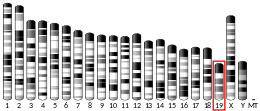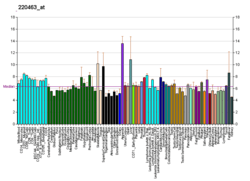TRPM3
Transient receptor potential cation channel subfamily M member 3 is a protein that in humans is encoded by the TRPM3 gene.[5]
Function
The product of this gene belongs to the family of transient receptor potential (TRP) channels. TRP channels are cation-selective channels important for cellular calcium signaling and homeostasis. The protein encoded by this gene mediates calcium entry, and this entry is potentiated by calcium store depletion. Alternatively spliced transcript variants encoding different isoforms have been -identified.[6] TRPM3 was shown to be activated by the neurosteroid pregnenolone sulphate in pancreatic beta cell. The activation causes calcium influx and subsequent insulin release, therefore it is suggested that TRPM3 modulates glucose homeostasis.[7]
TRPM3 Ligands
Channel Blockers
- Mefenamic acid[8]
- Citrus fruit flavonoids, E.g. Naringenin and hesperetin, as well as Ononetin (a deoxybenzoin).[9]
Agonist
- CIM0216
See also
References
- GRCh38: Ensembl release 89: ENSG00000083067 - Ensembl, May 2017
- GRCm38: Ensembl release 89: ENSMUSG00000052387 - Ensembl, May 2017
- "Human PubMed Reference:". National Center for Biotechnology Information, U.S. National Library of Medicine.
- "Mouse PubMed Reference:". National Center for Biotechnology Information, U.S. National Library of Medicine.
- Clapham DE, Julius D, Montell C, Schultz G (December 2005). "International Union of Pharmacology. XLIX. Nomenclature and structure-function relationships of transient receptor potential channels". Pharmacological Reviews. 57 (4): 427–50. doi:10.1124/pr.57.4.6. PMID 16382100.
- "Entrez Gene: TRPM3 transient receptor potential cation channel, subfamily M, member 3".
- Wagner TF, Loch S, Lambert S, Straub I, Mannebach S, Mathar I, Düfer M, Lis A, Flockerzi V, Philipp SE, Oberwinkler J (December 2008). "Transient receptor potential M3 channels are ionotropic steroid receptors in pancreatic beta cells". Nature Cell Biology. 10 (12): 1421–30. doi:10.1038/ncb1801. PMID 18978782.
- Klose C, Straub I, Riehle M, Ranta F, Krautwurst D, Ullrich S, Meyerhof W, Harteneck C (April 2011). "Fenamates as TRP channel blockers: mefenamic acid selectively blocks TRPM3". British Journal of Pharmacology. 162 (8): 1757–69. doi:10.1111/j.1476-5381.2010.01186.x. PMC 3081119. PMID 21198543.
- Straub I, Mohr F, Stab J, Konrad M, Philipp SE, Oberwinkler J, Schaefer M (April 2013). "Citrus fruit and fabacea secondary metabolites potently and selectively block TRPM3". British Journal of Pharmacology. 168 (8): 1835–50. doi:10.1111/bph.12076. PMC 3623054. PMID 23190005.
Further reading
- Oberwinkler J, Phillipp SE (2007). "TRPM3". Handbook of Experimental Pharmacology. 179 (179): 253–67. doi:10.1007/978-3-540-34891-7_15. PMID 17217062.
- Harteneck C, Reiter B (February 2007). "TRP channels activated by extracellular hypo-osmoticity in epithelia". Biochemical Society Transactions. 35 (Pt 1): 91–5. doi:10.1042/BST0350091. PMID 17233610.
- Held K, Voets T, Vriens J (2014). "TRPM3 in temperature sensing and beyond". Temperature. 2 (2): 201–13. doi:10.4161/23328940.2014.988524. PMC 4844244. PMID 27227024.
- Islam, Md. Shahidul, ed. (2011). Transient Receptor Potential Channels. Advances in Experimental Medicine and Biology. 704. New York: Springer Science+Business Media. doi:10.1007/978-94-007-0265-3. ISBN 978-94-007-0265-3. ISSN 2214-8019. OCLC 710148029.CS1 maint: ref=harv (link)
External links
- TRPM3+protein,+human at the US National Library of Medicine Medical Subject Headings (MeSH)
This article incorporates text from the United States National Library of Medicine, which is in the public domain.






